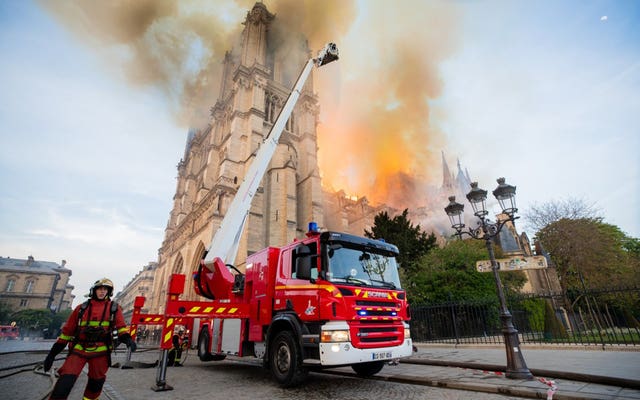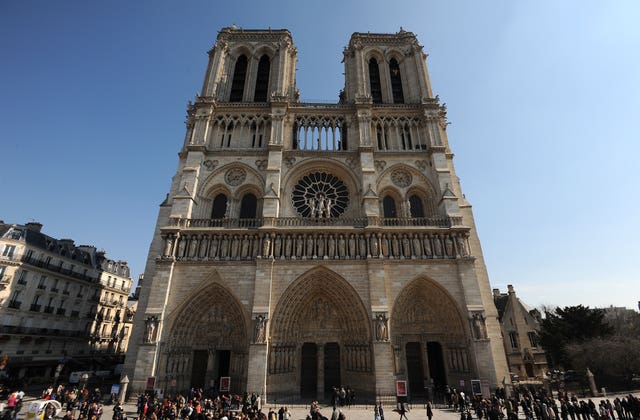
Notre Dame Cathedral will be rebuilt just the way it stood before last year’s devastating fire.
To stay historically accurate, it will again be built with potentially toxic lead.
French President Emmanuel Macron, who wants Notre Dame reopened in time for the 2024 Olympics, had initially pushed for a contemporary touch on top of the cathedral, prompting eye-catching proposals from architects around the world.
 French firefighters tackle the fire at Notre Dame cathedral (Benoit Moser/Pompiers de Paris/PA)
French firefighters tackle the fire at Notre Dame cathedral (Benoit Moser/Pompiers de Paris/PA)
But Mr Macron came around to the traditionalists’ argument and approved reconstruction plans for the 12th-century monument that were presented on Thursday, according to a statement from the state agency overseeing the project.
The plan includes recreating the 19th-century spire by Viollet Le Duc that collapsed in the fire, and “favours fidelity to the monument’s form and restoration of the cathedral in its latest state”, the statement said.
That means the state Notre Dame was in the afternoon of April 15 2019, before a fire broke out beneath its roof, toppling its spire, consuming the roof and threatening the rose-windowed twin towers that keep the cathedral upright.
More than a year later, the structure remains unstable.
 Notre Dame before the blaze (Andrew Matthews/PA)
Notre Dame before the blaze (Andrew Matthews/PA)
It took nearly a year to clear out dangerous lead residue released in the fire and to get to the point where workers could start removing scaffolding that had been in place before the fire for a previous renovation effort.
Actual reconstruction will not start until next year.
The reconstruction plan says it will replicate original materials “to guarantee the authenticity, harmony and coherence of this masterpiece of Gothic art”.
Those materials originally include tons of lead, which is raising concerns among health and environmental groups.
Toxic lead spewed by the fire forced schools in the area to close and prompted a lengthy, painstaking cleanup effort of the historic neighbourhood on an island in the centre of Paris.


Why are you making commenting on The Herald only available to subscribers?
It should have been a safe space for informed debate, somewhere for readers to discuss issues around the biggest stories of the day, but all too often the below the line comments on most websites have become bogged down by off-topic discussions and abuse.
heraldscotland.com is tackling this problem by allowing only subscribers to comment.
We are doing this to improve the experience for our loyal readers and we believe it will reduce the ability of trolls and troublemakers, who occasionally find their way onto our site, to abuse our journalists and readers. We also hope it will help the comments section fulfil its promise as a part of Scotland's conversation with itself.
We are lucky at The Herald. We are read by an informed, educated readership who can add their knowledge and insights to our stories.
That is invaluable.
We are making the subscriber-only change to support our valued readers, who tell us they don't want the site cluttered up with irrelevant comments, untruths and abuse.
In the past, the journalist’s job was to collect and distribute information to the audience. Technology means that readers can shape a discussion. We look forward to hearing from you on heraldscotland.com
Comments & Moderation
Readers’ comments: You are personally liable for the content of any comments you upload to this website, so please act responsibly. We do not pre-moderate or monitor readers’ comments appearing on our websites, but we do post-moderate in response to complaints we receive or otherwise when a potential problem comes to our attention. You can make a complaint by using the ‘report this post’ link . We may then apply our discretion under the user terms to amend or delete comments.
Post moderation is undertaken full-time 9am-6pm on weekdays, and on a part-time basis outwith those hours.
Read the rules hereComments are closed on this article